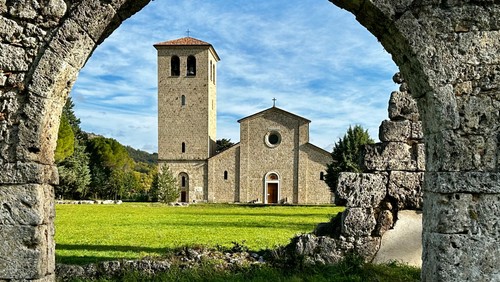
06/10/2025 0 Kommentare
On a journey of faith – slow, free, connected
On a journey of faith – slow, free, connected
On a journey of faith – slow, free, connected
# Pilgerinitiative-en
Veröffentlicht am Montag, 6. Oktober 2025 10:42

© Ellen Nemitz
On a journey of faith – slow, free, connected
From September 8 to 15, we were guests at the Benedictine monastery of San Vincenzo al Volturno in Italy as an ecumenical pilgrim community.
Here are some impressions from pilgrims reflecting on the pilgrim words slowness, freedom, spirituality, community, and carefreeness.
Slowness
By Gundula
Slowly upward, step by step toward the summit. Breathe deeply. Stop occasionally to catch your breath, take a sip of water, and enjoy the magnificent view. Let your gaze wander over the mountains, into the valley, to the cloud formations and the turquoise-colored lake below. Look at the trees and vegetation, or the stream, and watch the water splash over roots and stones. Slowness. Pilgrimage slows you down, and slowness shifts your perception, making it more intense, more beautiful.
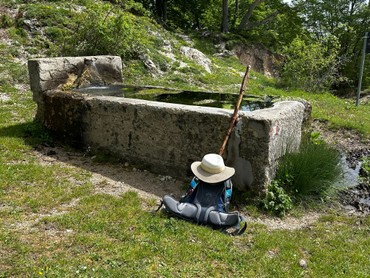
I am taking many of these beautiful impressions with me that we were able to experience on our pilgrimage. The images of mountains, sky, water, and forest. Of plants and fruits—pink ripe prickly pears, huge green citrus fruits, and red pomegranates. But also the sounds, the rustling of the wind and water, the cries of the birds and the chirping of the crickets. The smell of the forest, mountains, and stream; the feeling of the warm sun on my skin, my aching feet, and the ice-cold mountain water that soothed them. And last but not least, the taste of fresh figs, sweet and juicy straight from the tree, a welcome refreshment while hiking. Of blackberries and sloes. This trip left us with so many enriching impressions, and the slow pace allowed us to take them in and enjoy them with all our senses.
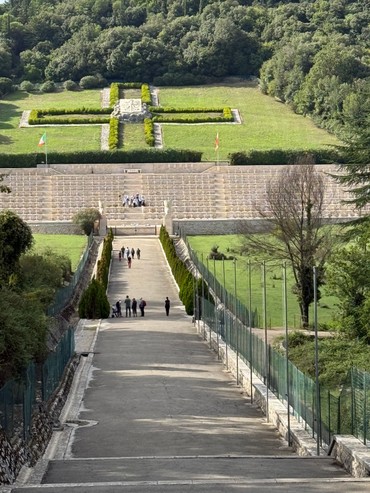
My personal highlight was visiting the Monte Cassino monastery, where St. Benedict founded the Benedictine order in the 6th century. It is located relatively high up on the mountain (which we did not hike up this time, but were driven up by car), so that you have a great view of the valley and the surrounding mountains and sky from there. Although much of the monastery was destroyed during World War II and subsequently rebuilt, we were still able to see some of the original walls, not least St. Benedict's cell. There is also an impressive church there, which is very richly decorated with lots of gold and beautiful colors. Beneath St. Benedict's tomb is a crypt with magnificent paintings on the walls and vaulted ceiling. And from one side of the monastery, you can see the nearby cemetery of Polish soldiers who fell here during World War II. It is located on a hillside in the shape of a cross and is within walking distance of the monastery. Here, the beauty and bitterness of history lie very close together, causing us to pause and reflect. In addition to these impressions, the day also brought us beautiful and enriching encounters with people who live here. For example, with Abbot Luca, who runs the Montecassino monastery, and with the Benedictine sisters who live on the lower slopes of the mountain and whose hospitality we enjoyed over lunch. It was a thoroughly enjoyable and interesting day.
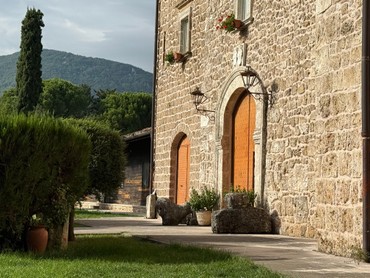
Freedom
by Olaf and Sabine
The keyword “freedom” accompanied us thematically on the challenging ascent to Monte Marone. We all decided, entirely voluntarily, to tackle the 800-meter climb, and we all made it. Two pilgrims were given strong support with guidance and applause during the last few meters.
Why do we do this to ourselves? Each of us decided to do so of our own free will. I think of Dietrich Bonhoeffer, who found wonderful words on death row. Does freedom begin within ourselves, is it our own decision to be free, regardless of external circumstances?
Somehow, freedom always feels greater on a mountain top, perhaps because we are a little closer to God? I think that God gives us the strength for freedom in our hearts, freely adapted from Bonhoeffer, “Wonderfully sheltered by good powers.”
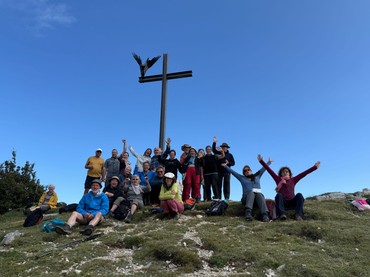
Spirituality and community at St. Vincenzo
As soon as we arrived at St. Vincenzo, we sensed that this was a special place. Sister Gabriela welcomed us so warmly that we immediately felt at home. With a loving smile, she asked us our names again – a small moment that expressed so much closeness. Between the small chapel on the left and the dining room on the right, a world opened up to us that we were able to share with the sisters for a few days. Every evening, we were treated to a delicious meal there – an expression of hospitality that went far beyond the culinary. It was precisely this space between community and spirituality that accompanied us figuratively throughout the week.
We were particularly moved by the singing in Lauds and Compline. For me, Olaf, this form of spirituality was new, but not unfamiliar. I immediately felt welcomed, carried by the atmosphere and the smile of the prioress, whose kindness had something knowing and reassuring about it.
For me, Sabine, the question arose as to what role monastic life plays in our society today. It was impressive to hear how the sisters seek their own path with God, without missionary pretensions – and precisely because of this, they have an enormous charisma. A lot has happened here in the last ten years. Simply by being themselves, by what they do, they bring about change, renewal, and inspiration.
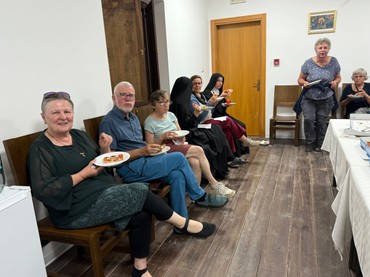
Valuable conversations also arose among us pilgrims. We shared our experiences of faith – as Protestant or Catholic Christians, or without any denominational affiliation at all. A special experience was the Protestant service in the chapel. Sister Frederica translated the German sermon into Italian for her fellow sisters – a reversal of the usual roles at Mass, which moved us deeply.
We will also carry Sister Federica's story in our hearts for a long time to come – how she found her way to the convent and came by her new name. It is encounters like these that bring spirituality and community to life.
For us, St. Vincenzo was a place that reconnected us as pilgrims – with ourselves, with others, and with what we call “spirituality.”
Carefree
Barbara Eger, Protestant, from Hennigsdorf near Berlin
This pilgrimage was special to me in several ways:
My first pilgrimage
1. With a large group – until now, I had always traveled alone or with a maximum of two other people.
2. Staying overnight in one place – until now, I had always changed accommodations along the pilgrimage route.
3. With spiritual life according to the prayer times in the monastery – until now, I had always been accompanied by individual biblical impulses or daily themes.
4. With regular delicious meals – until now, I had lived out of my backpack and whatever came my way.
I was able to practice “carefreeness” in many ways on the pilgrimage.
Just by not having to organize the pilgrimage, I was able to adopt a certain carefreeness. This was a rather unfamiliar way of life for me and at the same time an immense relief. Finally, I didn't have to have everything under control, but could surrender myself completely to the moment.
So every day I let myself be surprised by which path, which impulse, which sights, and also which challenges awaited me. The peace and contemplation that came with this did me good and visibly slowed me down.
The communal prayer times and morning mass did me a lot of good. Deep down, however, I continue to suffer from the fact that we are still separated at the Lord's table. The hospitality of the sisters and the community within the pilgrim group, the mutual exchange and the inspiration we gave each other were priceless gifts on the path that I walked and continue to walk every day with confidence.
A special highlight of the trip for me was the visit to Montecassino Abbey. My birthday is February 10, the feast day of St. Scholastica. From an early age, I felt a closeness and deep connection to her, as well as to the theology of her brother, St. Benedict. Being at the site of their work touched me deeply.
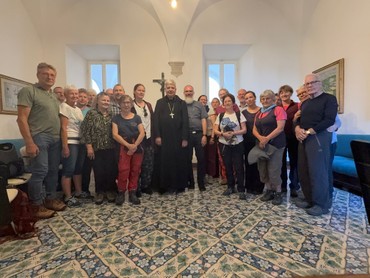


Kommentare